
Buenos Aires was founded twice, once in 1536 by Pedro de Mendoza, then in 1580 by Juan de Garay. Here is a statue to Juan de Garay.

Buenos Aires started out as a very scruffy town, but by 1776 it had grown enough in both power and prestige to become the seat of the Viceroy of Rio de la Plata.
Whenever the Spanish started a new city in the New World, they built a substantial building called the Cabildo. The Cabildo served all the functions of govenment: administrative, legal, and judiciary. This is the Cabildo of Buenos Aires, with nice purple flowering Jacaranda trees around it.



Taking pictures inside the Cabildo is not allowed, but from the Cabildo, I observed a dance exhibition.
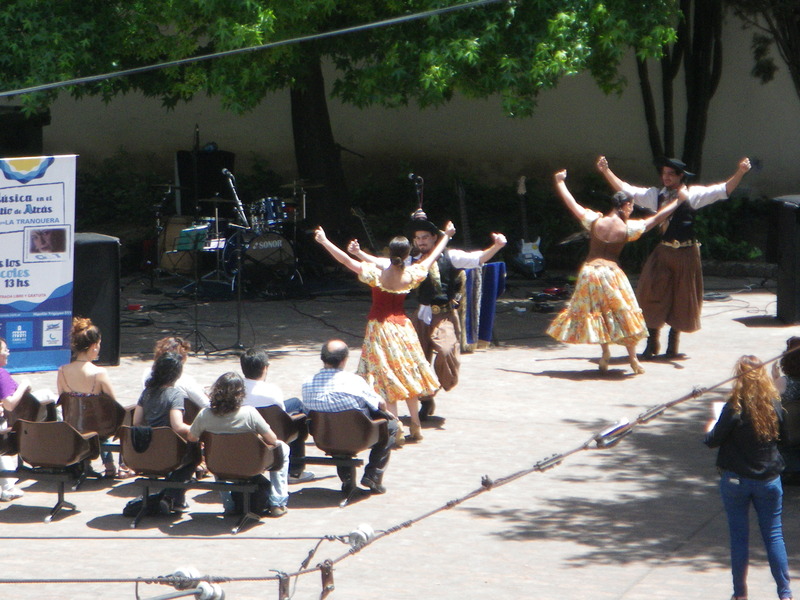


I did not observe anyone doing Tango, the dance that originated in Buenos Aires. Perhaps I was not in the right neighborhoods at the right time. But I did find a statue, "Monumento al Tango", and one of many places that offers Tango lessons.


During the Napoleonic wars, Argentina was still a colony of Spain, and Napoleon's armies gradually conquered Spain. Great Britain was permanently at war with Napoleon, so the British attacked Buenos Aires, twice. In 1806 they took and held Buenos Aires until they were defeated by an army from Montevideo, which is now in Uruguay. In 1807, the British conquered Montevideo first, but when they attempted to take Buenos Aires again, they were repulsed by a militia of local citizens. The well-off local citizens of Spanish descent were known as Criollos (creoles), and in defending their city, they realized the power they had.
On the 22nd of May, 1810, with the government in Spain in shambles as a result of Napoleon's invasion, a group of Criollos took a petition to the Cabildo, asking the Viceroy to step down. And they must have asked rather persuasively, because he stepped down as Viceroy. He was then promptly named to lead the junta that replaced the Spanish government.
Today's Plaza de Mayo has the Cabildo at one end, and the presidential palace, the Casa Rosada, across the square.






Avenida de Mayo begins in Plaza de Mayo and ends gracefully in Plaza de los Dos Congresos, in front of the congress building. This building is somewhat modeled on the building of the U.S. congress in Washington D.C.




On July 9, 1816, with Napoleon in exile on St. Helena, the government of Argentina proclaimed its independence from Spain.
This is the Avenida 9 Julio, with an obelisk to mark the 4th centenennial of the first founding of Buenos Aires, in 1936.

Along the Avenida 9 Julio are interesting sculptures, including one of Don Quijote.


And one on the side of a building.

I have noticed quite a few very wide streets in Buenos Aires. The city and its surrounding metro area have more than 12 million inhabitants, so I guess the wide streets are needed to hold all the cars. I counted 13 lanes on one of the one-way streets I crossed, and this picture shows 9 cars lined up waiting for the light to change.

There are also some narrow streets. Downtown Buenos Aires is called the microcentro, and the main shopping street in the microcentro is Calle Florida, which is a pedestrian zone. On Calle Florida is the upscale shopping center Galeria Pacifico, with decor that includes painted ceilings.



Long before shopping centers or the events of the 1810s, in 1675, the Jesuits began to build a small church not far from what is now the Plaza de Mayo. The final church on this site was completed by 1734, and is not so small. The church is named for San Ignacio de Loyola, and is the oldest surviving church in Buenos Aires.



I am still a sailor, so I paid my respects at the church of St. Nicholas of Bari. The name is a misnomer -- St. Nicholas was from Turkey, and his remains were moved to Bari long after his death. But maybe it is because of his remains' trip that he is the patron saint of sailors.


Just wandering around town I also found a Sinagogue. Buenos Aires is supposed to be very open and tolerant.

The church of Nuestra Senora del Pilar was built as the church for a fransciscan monastery that was far outside the city at the time. The franciscan brothers, known as Recollects in English, devoted their lives to spiritual reflection. From their name, the area of the city around this church is now known as Recoleta, and since the 1870s has been one of the wealthier areas of Buenos Aires.



As a consequence of the wealth of the neighborhood, the cemetery of Recoleta has the tombs of many famous people, including Eva Duarte Peron, influential wife of Juan Peron, who was president of Argentina in the 1940s, 1950s, and 1970s. Eva Peron died in 1952 at the age of 33.

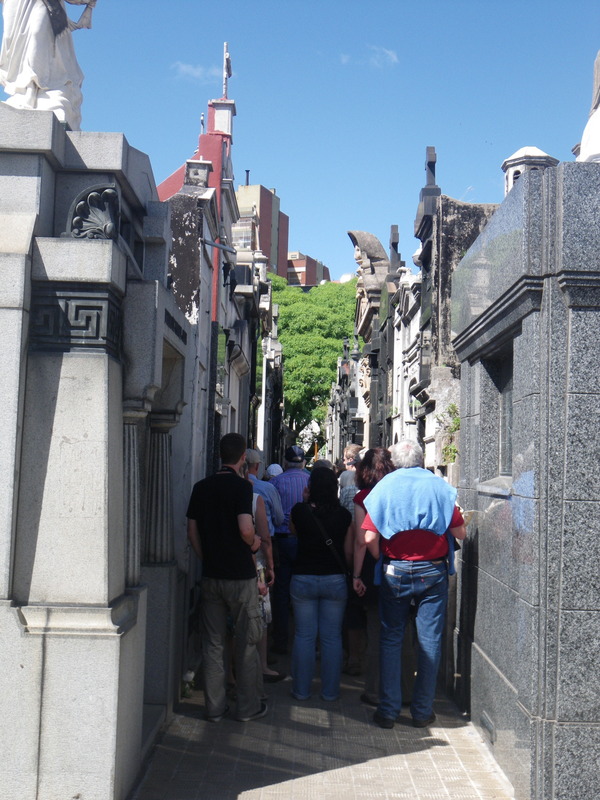

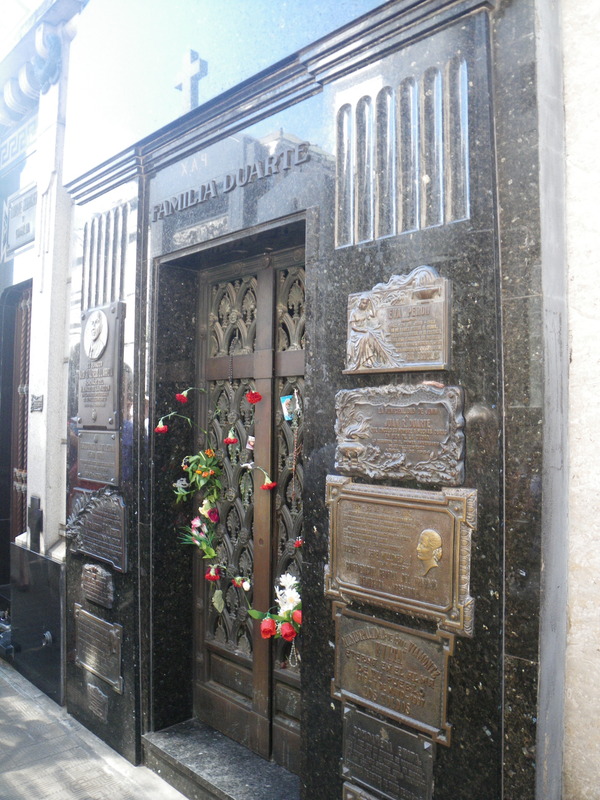

There is a museum dedicated to Eva Peron, or Evita. She was a famous radio personality and part-time actress from a poor family when she met minister and Vice President Juan Peron. They scandalized polite society by living together before getting married. Evita herself had been born to unmarried parents, something she tried to disguise by claiming to be three years younger than she was. After about a year, Evita and Juan Peron were married, and within a few months of their marriage, Juan Peron had been elected president.

She participated actively in both the presidential campaign and the presidency. In 1951 she started to faint more and more frequently, and eventually was diagnosed with ovarian cancer. After her death, the public feeling in Argentina was was probably comparable to public feelings about Lady Diana after she passed away.
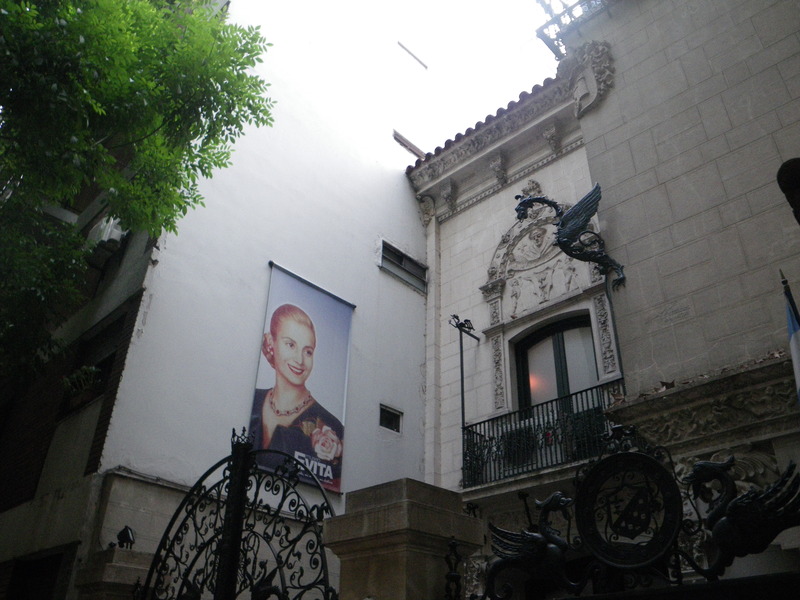
This is her death mask, of silver although the color came out wrong in the picture.

The museum is housed in a building she designated for women moving to Buenos Aires from other parts of the country who had problems of documentation, health, work, or living in Buenos Aires, so they would not "succumb to temptation and vice".

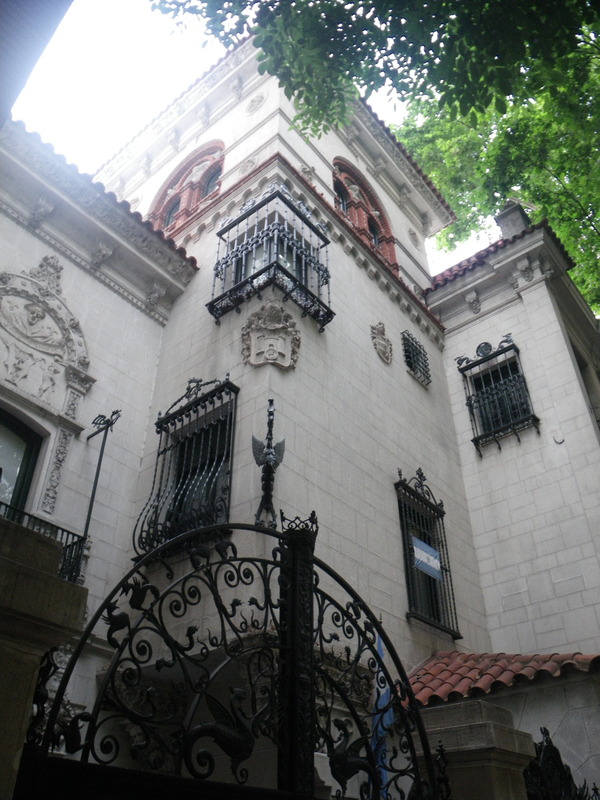

The museum also includes many of her dresses. I noticed that the women visiting the museum seemed quite interested in the clothing.


The cemetery of Recoleta as a whole is quite interesting. It fits the word necropolis, a city for the dead, with streets and house-like monuments.





The other person I've heard of who is buried in the cemetery of Recoleta is President Sarmiento, whose tomb has a small obelisk with a condor flying over it.



I have heard of president Sarmiento because the Navy named a training ship after him.





The area near the ship, Puerto Madero, is the former docklands, and has been renovated and gentrified. There is a new pedestrian bridge (Puente de la Mujer) with a fancy design, old yellow cranes, and old brick buildings that have been filled with expensive shops and restaurants.





Further towards the sea from Puerto Madero is a swampy area that is more or less kept in a natural state, though I saw many plants of ricin, which is invasive here as elsewhere. The area has the name Reserva Ecologica.



At the edge of the Reserva Ecologica I saw three interesting birds that I had not seen elsewhere. So I guess the Reserva is effective in maintaining biodiversity.



Although Eva and Juan Peron are no longer actively contributing to the political life of the country, political life in Buenos Aires still seems to be quite lively. There are many memorials and many signs about the Islas Malvinas (in English, the Falkland islands), over which in 1982 Argentina unsuccessfully fought Great Britain. Some of the signs claim that the Malvinas "were, are, and will be Argentine" ("fueron, son, y seran Argentinas"), even on the side of a food kiosk near the Reserva Ecologica.

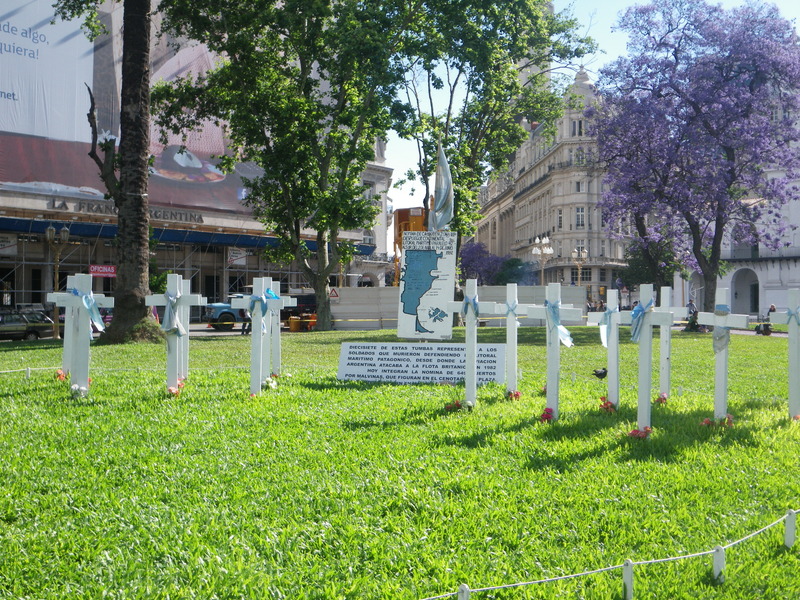


At a different food Kiosk, I found an excellent churrasco (barbecued beef) sandwich for 20 pesos, or about 4 US dollars. As restaurants go in Buenos Aires, 20 pesos is a very good price, since I am more used to finding meals that cost around 50 pesos.
Besides the Islas Malvinas, on which nobody in Argentina seems to disagree, there are disputes that seem to be more economically or class motivated. I saw two demonstrations. The first is inpired by Anibal Veron, who was shot and killed in 2000 after protesting against his employer. I am not sure what the second demonstration was about.
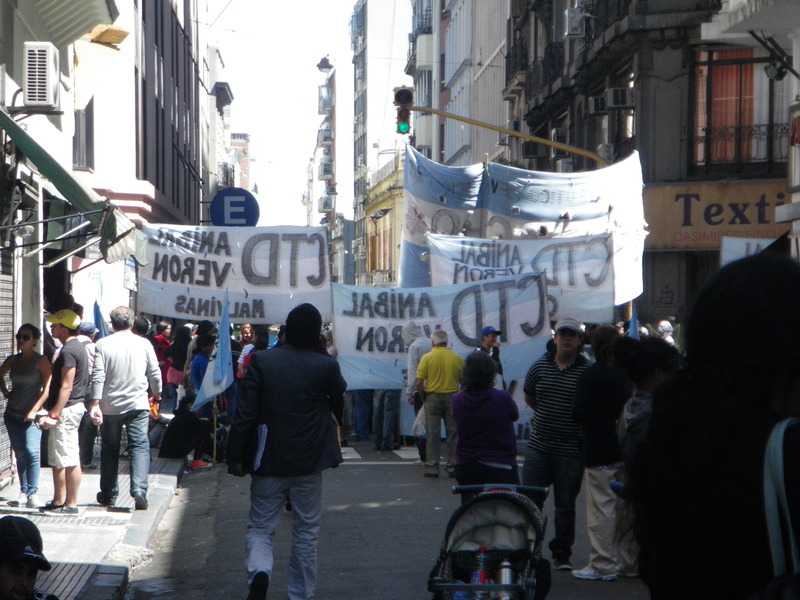

Both of these demonstrations were near the Plaza de Mayo, which I would guess attracts most of the political attention in Buenos Aires.
For a long time Buenos Aires was the main port of Argentina, and so someone from Buenos Aires is known as a Porteno. This little store is advertising its credentials as selling local food, and I can confirm that the chicken empanadas are good. An empanada is meat baked inside a shell of bread.

As anyone from Italy knows, Palermo is the capital of Sicily. But as anyone from Buenos Aires knows, Palermo is a neighborhood of Buenos Aires.

And so www.palermo.edu, the university of Palermo, is actually the Universidad de Palermo in Buenos Aires, rather than the Universita' degli Studi di Palermo, www.unipa.it.
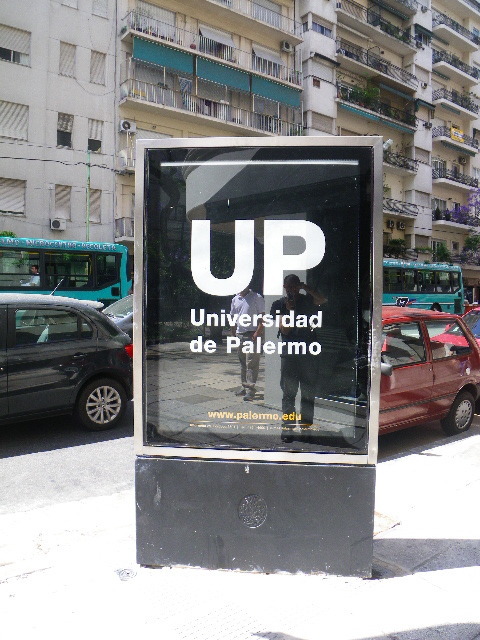
Palermo is a large neighborhood, and includes some very nice parks, featuring birds, trees, amateur acrobats, places to borrow a free bicycle, and a statue of Mohandas K. Gandhi.






I found some Linden trees in flower. In the Northern hemisphere, these trees usually flower in May or June. I love their sweet fragrance.
